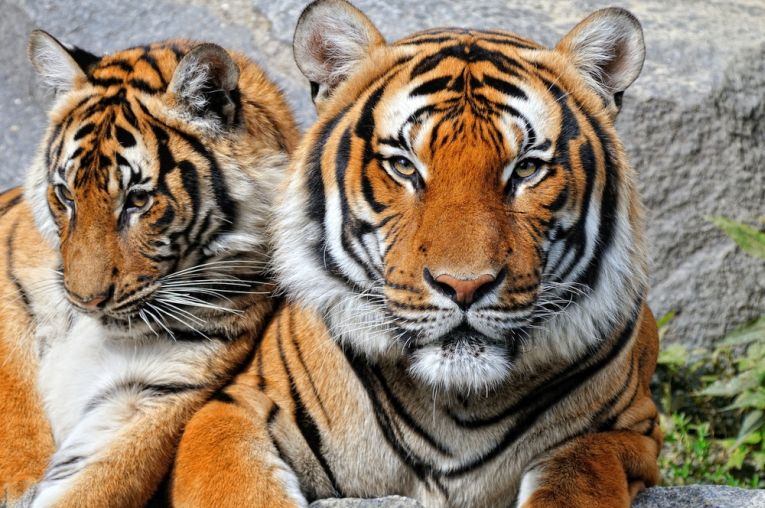Tuesday, July 29th is International Tiger Day, an annual celebration raising awareness for tiger conservation. Founded in 2010 during the Saint Petersburg Tiger Summit, it is an international effort to draw worldwide attention to severely declining native populations of tigers and their ecosystems. It also serves to highlight the tigers who remain, and groups working to save them.
Tigers face constant threats to their survival. Deforestation is decreasing not only habitats but prey. With limited regions where they can live and hunt safety, tigers are facing more encounters with humans. This leads to higher levels of stress which are severely detrimental to big cats. For tigers, their most infamous threat is poaching and sale on the illegal wildlife trade market.
Their skins, bones and other various body parts are consumed for traditional medical or as status symbols. As the economies of consumer countries grow, business for tiger products is booming.vEfforts to protect tigers from deforestation and poaching are varied but have a few common elements:
Parks and Preserves:
Probably the most common method for wildlife conservation, the establishment of a protected habitat is imperative for a successful program. The largest of these for tiger protection is the Hukaung Valley Tiger Reserve in Myanmar. Supported by Panthera and covers nearly 22,000 square kilometers and provides a home for around 50 tigers. Supplementing parks like the Hukaung Valley are wildlife corridors. These allow tigers and other species to move between protected zones ensures that the genetic pool remains balanced.
Law Enforcement:
Once parks are established, forest rangers and local law enforcement are necessary to maintain the safety of the inhabitants. To do this successfully, cooperation between local governments and conservation organizations is important. Local law enforcement have an understanding of the land and the people, while international organizations have the knowledge of the nuances of wildlife conservation. The Wildlife Trust of India recently followed this method and trained a select group from the Forest Department based on issues that would arise in the field or in crime prevention. This style of specialized law enforcement support within tiger habitats is a method used across Asia, from India to Russia, down to Cambodia.
Community Cooperation:
One of the most important pieces of a successful conservation programs is a strong educational program which guarantees that there is a long-term impact of conservation. In Cambodia, the Wildlife Alliance works directly with the community with their mobile education unit, the Kouprey Express. This allows them to work towards conservation by encouraging children to protect animals, recycle and live sustainable lives. By reaching out to school children and their families, conservation groups can foster a respect and drive to protect the environment.
International Regulations:
Also necessary to tiger protection is the support of large scale international regimes, notably the Convention on International Trade in Endangered Species of Wild Fauna and Flora (CITES) and the International Union for Conservation (IUCN), which can create global legislation. CITES works to regulate trade in plant and animal species between borders to ensure that trade does not lead to extinction.
Species are listed among three appendices based on the protection needed and thus international trade controls are placed. All tiger subspecies are threatened with extinction which could be affected by trade and are thus listed on Appendix I. The IUCN published the Red List of Threatened Species which is imperative to international conservation efforts. This is body that monitors species populations and determines their conservation status. In addition, the IUCN is the oldest and largest global environmental network.
While there are a number of international efforts to protect the tigers, there are also a number of continued threats. Deforestation is a constant threat to the tigers' natural habitats and due to the increasing development in many regions of Asia; this trend is likely to continue. As the human populations continue to expand, so does the need for space to farm and live. The expanding human population also can become a source of competition for the tigers as there is a shared taste in meat.
Poaching is the largest and most highlighted of tiger threats. Their use in traditional medicines and trade as status symbols in China has created a demand that is unlikely to cease. Today there are tiger farms, where pelts and bones are collected. While tiger farms have many additional issues based on the inhuman conditions farm tigers are kept, these farms fuels the demand of tiger products, wild or not.
This makes it worthwhile to hunt wild tigers which are cheaper to "harvest" than farmed tigers that need to be fed. This not always viewed as an illegal action either, recently a Chinese delegate stated that while the Chinese ban the trade in tiger bones, trade in tiger skins is not. It is just another commodity.
Although there is a strong international effort to protecting wild tigers, there are still many problems standing in their way. We have an encyclopaedia entry here as Encyclopaedia on Tigers that tries to approach the poaching and other problems, while another of our many tiger tales has positive news from tiger-cams in Sumatra-home of the smallest living tiger. It is called WWF Releases Rare Footage.










